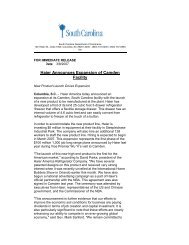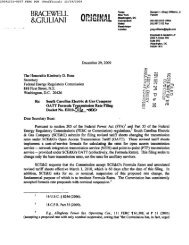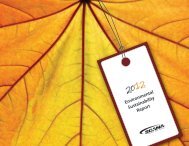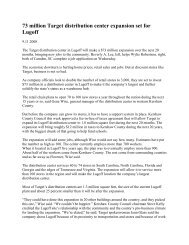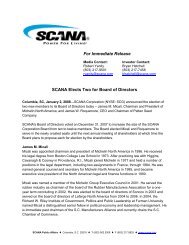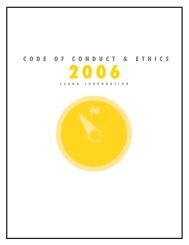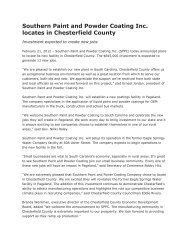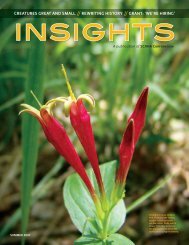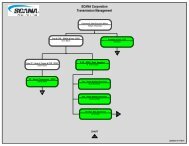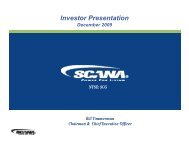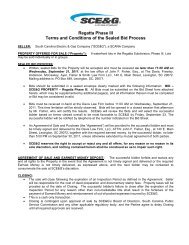10-K - SCANA Corporation
10-K - SCANA Corporation
10-K - SCANA Corporation
Create successful ePaper yourself
Turn your PDF publications into a flip-book with our unique Google optimized e-Paper software.
Table of Contents<br />
SCE&G currently maintains policies (for itself and on behalf of Santee Cooper) with NEIL. The policies provide coverage to<br />
the nuclear facility for property damage and outage costs up to $2.75 billion. In addition, a builder’s risk insurance policy has been<br />
purchased from NEIL for the construction of the New Units. This policy provides the Owners up to $500 million in limits of<br />
accidental property damage occurring during construction. All of the NEIL policies permit retrospective assessments under certain<br />
conditions to cover insurer’s losses. Based on the current annual premiums, SCE&G’s portion of the prospective premium assessment<br />
would not exceed $37.3 million.<br />
To the extent that insurable claims for property damage, decontamination, repair and replacement and other costs and expenses<br />
arising from a nuclear incident at Summer Station Unit 1 exceed the policy limits of insurance, or to the extent such insurance<br />
becomes unavailable in the future, and to the extent that SCE&G rates would not recover the cost of any purchased replacement<br />
power, SCE&G will retain the risk of loss as a self-insurer. SCE&G has no reason to anticipate a serious nuclear incident. However, if<br />
such an incident were to occur, it likely would have a material impact on the Company’s results of operations, cash flows and financial<br />
position.<br />
Environmental<br />
SCE&G<br />
In December 2009, the EPA issued a final finding that atmospheric concentrations of GHG endanger public health and<br />
welfare within the meaning of Section 202(a) of the CAA. The rule, which became effective in January 20<strong>10</strong>, enables the EPA to<br />
regulate GHG emissions under the CAA. The EPA has committed to issue new rules regulating such emissions in 2012. The<br />
Company expects that any costs incurred to comply with GHG emission requirements will be recoverable through rates.<br />
In 2005, the EPA issued the CAIR, which required the District of Columbia and 28 states, including South Carolina, to<br />
reduce nitrogen oxide and sulfur dioxide emissions in order to attain mandated state levels. CAIR set emission limits to be met in two<br />
phases beginning in 2009 and 2015, respectively, for nitrogen oxide and beginning in 20<strong>10</strong> and 2015, respectively, for sulfur dioxide.<br />
SCE&G and GENCO determined that additional air quality controls would be needed to meet the CAIR requirements. On July 6,<br />
2011 the EPA issued the CSAPR. This rule replaced CAIR and the Clean Air Transport Rule proposed in July 20<strong>10</strong> and is aimed at<br />
addressing power plant emissions that may contribute to air pollution in other states. CSAPR requires states in the eastern United<br />
States to reduce power plant emissions, specifically sulfur dioxide and nitrogen oxide. On December 30, 2011, the United States<br />
Court of Appeals for the District of Columbia issued an order staying CSAPR and reinstating CAIR pending resolution of an appeal of<br />
CSAPR. Air quality control installations that SCE&G and GENCO have already completed should assist the Company in complying<br />
with the CSAPR and the reinstated CAIR. The Company will continue to pursue strategies to comply with all applicable<br />
environmental regulations. Any costs incurred to comply with this rule or other rules issued by the EPA in the future are expected to<br />
be recoverable through rates.<br />
In 2005, the EPA issued the CAMR which established a mercury emissions cap and trade program for coal-fired power<br />
plants. Numerous parties challenged the rule and, on February 8, 2008, the United States Circuit Court for the District of Columbia<br />
vacated the rule for electric utility steam generating units. In March 2011, the EPA proposed new standards for mercury and other<br />
specified air pollutants. The rule, which becomes effective on April 16, 2012, provides up to four years for facilities to meet the<br />
standards. The rule is currently being evaluated by the Company. Any costs incurred to comply with this rule or other rules issued by<br />
the EPA in the future are expected to be recoverable through rates.<br />
SCE&G has been named, along with 53 others, by the EPA as a PRP at the AER Superfund site located in Augusta, Georgia.<br />
The PRPs funded a Remedial Investigation and Risk Assessment which was completed and approved by the EPA and funded a<br />
Feasibility Study that was completed in 20<strong>10</strong>. A clean-up cost has been estimated and the PRPs have agreed to an allocation of those<br />
costs based primarily on volume and type of material each PRP sent to the site. SCE&G’s allocation did not have a material impact on<br />
its results of operations, cash flows or financial condition.<br />
84



